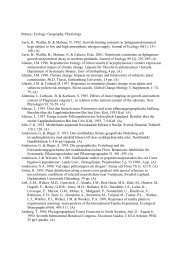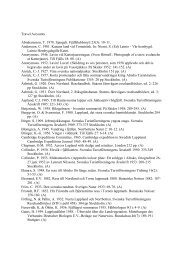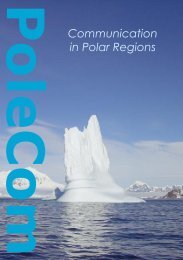Ladda ner årsbok 2008 (6,5 MB) - Polarforskningssekretariatet
Ladda ner årsbok 2008 (6,5 MB) - Polarforskningssekretariatet
Ladda ner årsbok 2008 (6,5 MB) - Polarforskningssekretariatet
Create successful ePaper yourself
Turn your PDF publications into a flip-book with our unique Google optimized e-Paper software.
Principal investigators<br />
Kurt h. Kjær<br />
Natural History Museum<br />
University of Copenhagen, Denmark<br />
nicolaj K. larsen<br />
Department of Geology<br />
Geo Biosphere Science Centre<br />
Lund University<br />
Participants<br />
svend Funder<br />
niels J. Korsgaard<br />
Natural History Museum<br />
University of Copenhagen, Denmark<br />
henriette C. linge<br />
Bjerknes Centre for Climate Research<br />
Bergen, Norway<br />
Figure 1<br />
Southwest Greenland with sample<br />
locations.<br />
48<br />
Nuuk<br />
¸<br />
Qooquut<br />
Sarqarssuaq !<br />
!<br />
Sermilik<br />
!<br />
Past impact of warming on<br />
the greenland Ice sheet<br />
The objective of this project is to investigate<br />
how the ice margin of the Greenland Ice Sheet<br />
reacted to earlier periods of warming, the<br />
interrelationship between sea ice and sea level<br />
changes and furthermore, to ascertain how<br />
such changes affected human adaptation and<br />
migration. This research is part of the Danishled<br />
RINK project, Respons af Indlandsisen til<br />
Naturlige Klimaændringer.<br />
The activities reported here mark the first<br />
field season within the RINK project in southwest<br />
Greenland. Our main purpose was to<br />
collect rock samples for cosmogenic exposure<br />
dating from high altitude bedrock and erratics<br />
in a 100 km transect from nunataks to the<br />
outer coast. The set of exposure dates is intended<br />
to give an overall estimate of the<br />
thinning and recession of the ice margin<br />
during the last 10 000 years. Other objectives<br />
were to locate marine and lacustrine sedimentary<br />
archives and map landforms indicative<br />
of glacial erosion and sediment accumu-<br />
Qingarssuak<br />
!<br />
Tasserssuaq<br />
!<br />
Sermilik gl.<br />
Nunatak 2<br />
FoRSKARRAPPoRTER CRUISE REPoRTS SWEDARCTIC <strong>2008</strong><br />
!<br />
!<br />
Nunattarssuk E<br />
Nunattarssuk W<br />
!<br />
Qardlît Nunât<br />
Nunatak 1390<br />
0 5 10 20 30 40 50<br />
Kilometers<br />
!<br />
!<br />
lation. The study area was chosen because the<br />
Inland Ice margin in this region is known for<br />
its vigorous response to climate change such<br />
as the Little Ice Age and the recent warming in<br />
the 20th and 21st century.<br />
Fieldwork<br />
During three weeks in June and July, we<br />
worked from four different field camps<br />
south of Nuuk, covering an area of the size<br />
of Skåne. Our mode of transport was a small<br />
helicopter, which meant that the equipment<br />
had to be kept at a minimum and our main<br />
study sites were two nunataks, which are<br />
exposed mountains surrounded by glacier<br />
ice. The first, Nunatak 1390, is located 15 km<br />
within the Inland Ice, while the second is<br />
located closer to the ice margin in the middle<br />
of the Sermilik Glacier. The nunataks are<br />
1–2 km wide, 5–12 km long and the highest<br />
point is approximately 3–400 metre above the<br />
ice surface from where the view of the local<br />
¸<br />
!<br />
Greenland<br />
GEUS base camp<br />
Sample sites for cosmogenic<br />
exposure dating








